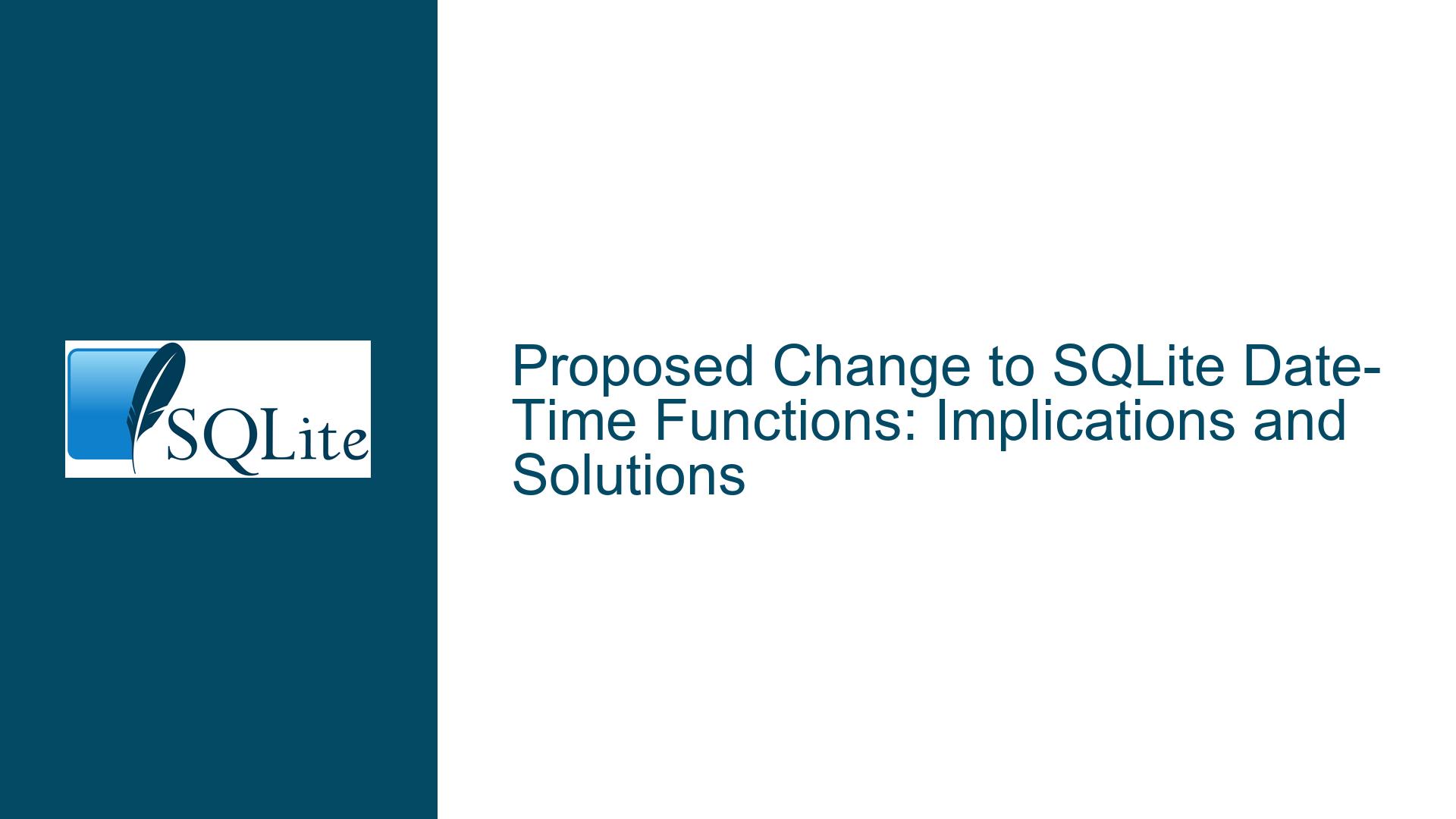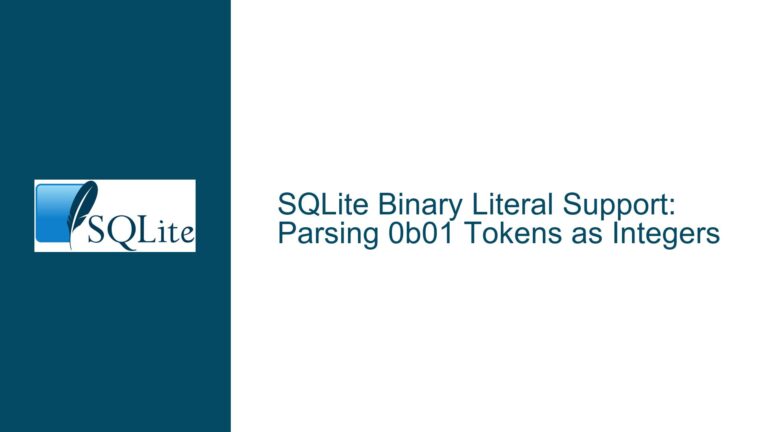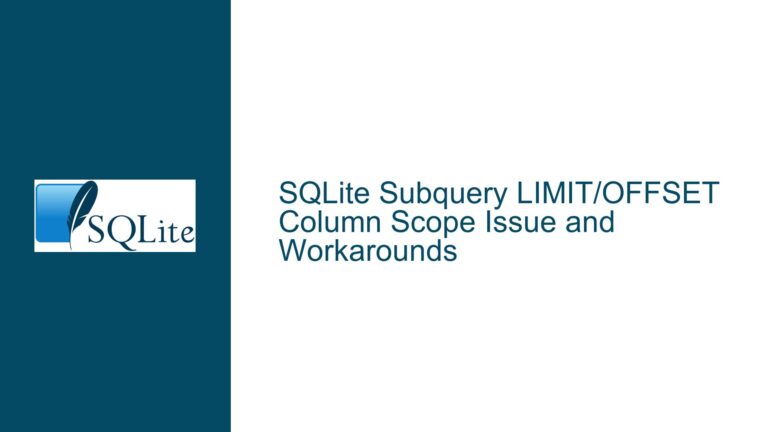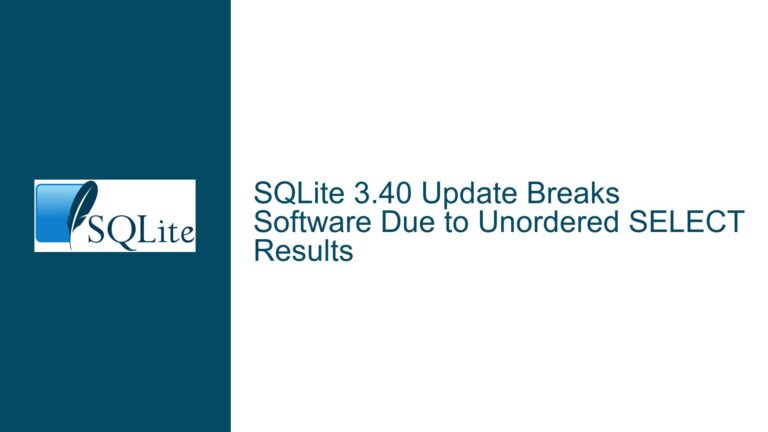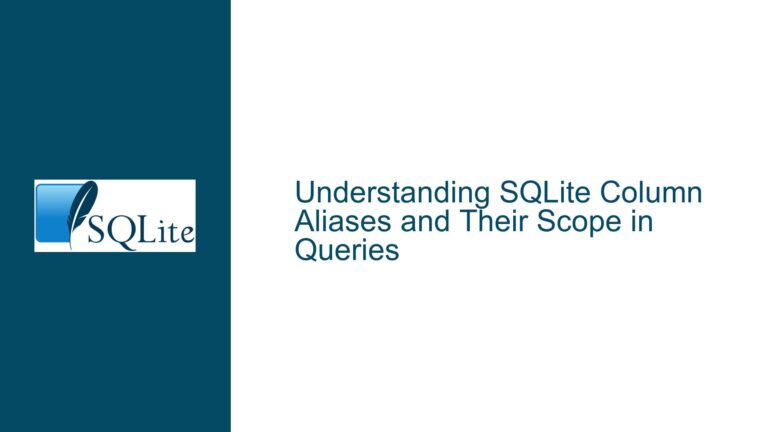Proposed Change to SQLite Date-Time Functions: Implications and Solutions
Understanding the Current Date-Time Representation in SQLite
SQLite currently supports three primary representations for date and time values: TEXT, REAL, and INT. The TEXT format follows the ISO-8601 standard, represented as YYYY-MM-DD HH:MM:SS.SSS. The REAL format uses the Julian day number, which counts the number of days since noon in Greenwich on November 24, -4714, according to the proleptic Gregorian calendar. The INT format represents Unix time, which is the number of seconds since January 1, 1970, 00:00:00 UTC.
SQLite’s date-time functions, such as date(), datetime(), time(), julianday(), and strftime(), can accept arguments in either TEXT or REAL formats. When an INT value is provided, it is interpreted as a Julian day number unless the 'unixepoch' modifier is explicitly used. This design allows for flexibility in how date and time values are stored and queried, but it also introduces some complexities, especially when dealing with legacy applications or specific use cases that rely on the current behavior.
The Proposed Change: Automatic Interpretation of INT Values as Unix Timestamps
The proposed change aims to simplify the interpretation of INT values in date-time functions. Under the new proposal, if an INT value is not within the range of 1721060 to 5373483 (which corresponds to the valid range of Julian day numbers for dates between 0000-01-01 and 9999-12-31), it will automatically be interpreted as a Unix timestamp. This means that the 'unixepoch' modifier would become redundant in such cases, although it could still be used for clarity or backward compatibility.
The primary benefit of this change is that it would allow queries to invoke SQL functions like datetime() on a column of type DATETIME without worrying about the underlying storage format. Columns intended to store date-time values could hold a mixture of TEXT, REAL, and INT values, and queries using date-time functions would always be able to interpret these values correctly. This would reduce the need for explicit modifiers and make the system more intuitive for developers.
However, this change is not without potential drawbacks. One of the main concerns is the ambiguity that arises for numeric inputs within a specific range. For example, INT values between 1970-01-20 22:04:19 and 1970-03-04 04:38:03 could be interpreted as either Julian day numbers or Unix timestamps. This ambiguity could lead to unexpected behavior in applications that rely on the current interpretation of these values.
Potential Breakage and Compatibility Issues
The proposed change could potentially break legacy applications that rely on the current behavior of SQLite’s date-time functions. Specifically, applications that store Julian day numbers as INT values or Unix timestamps from the first three months of 1970 as REAL values could be affected. While the number of such applications may be small, the impact on those that do exist could be significant.
One scenario where this change could cause issues is in applications that store historical dates as Julian day numbers. For example, if an application only deals with dates (and not times), it might store Julian day numbers as INT values for efficiency. Under the proposed change, these INT values would be interpreted as Unix timestamps, leading to incorrect date calculations. This could be particularly problematic for applications that deal with historical data, where the precision of the date is more important than the time.
Another potential issue arises from the way SQLite handles numeric values with different affinities. If a column has an INTEGER affinity, inserting a value like 22 or 22.0 will always return 22. If the column has a REAL affinity, inserting 22 or 22.0 will always return 22.0. However, if the column has a NUMERIC or BLOB affinity, the value returned will be exactly what was inserted. This behavior could lead to unexpected results when dealing with date-time values, especially if the application relies on the specific format of the stored data.
Mitigating the Risks: Proposed Solutions and Best Practices
To mitigate the risks associated with the proposed change, several solutions have been suggested. One approach is to introduce a new modifier, such as 'julianday', that forces the date-time argument to be interpreted as a Julian day number, even if it is an INT value. This would provide a way to maintain backward compatibility for applications that rely on the current behavior.
Another suggestion is to introduce a pragma setting that allows developers to specify how numeric arguments should be interpreted. For example, a pragma like pragma epoch = JULIAN could be used to enforce the current behavior, while pragma epoch = UNIX could be used to interpret numeric values as Unix timestamps. This would give developers more control over how date-time values are interpreted and allow them to choose the behavior that best fits their application’s needs.
A more radical approach would be to introduce a new modifier, such as 'auto', that allows the function to decide the format based on the type of input. This would provide a way to automatically interpret date-time values without breaking existing code. However, this approach would require careful documentation and testing to ensure that it does not introduce new ambiguities or unexpected behavior.
In addition to these technical solutions, it is important to consider the broader implications of the proposed change. For example, developers should be aware of the potential impact on legacy applications and take steps to test their code before adopting the new behavior. This might involve updating existing queries to use the new modifiers or pragma settings, or even migrating data to a new format that is more compatible with the proposed changes.
Conclusion: Balancing Innovation and Compatibility
The proposed change to SQLite’s date-time functions represents a significant step forward in terms of flexibility and ease of use. By automatically interpreting INT values as Unix timestamps, the new behavior would simplify many common use cases and reduce the need for explicit modifiers. However, this change also introduces potential risks, particularly for legacy applications that rely on the current behavior.
To address these risks, it is important to consider a range of solutions, from new modifiers and pragma settings to careful documentation and testing. By taking a balanced approach that prioritizes both innovation and compatibility, SQLite can continue to evolve as a powerful and reliable database system while minimizing the impact on existing applications.
Ultimately, the decision to adopt the proposed change will depend on a careful evaluation of the benefits and risks, as well as feedback from the SQLite community. By engaging in a thoughtful and collaborative discussion, developers can help ensure that SQLite remains a versatile and robust tool for managing date and time data in a wide range of applications.
